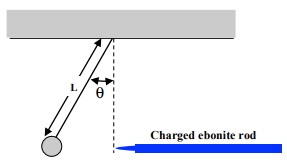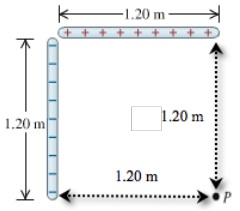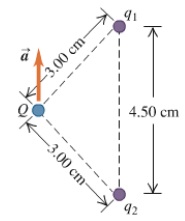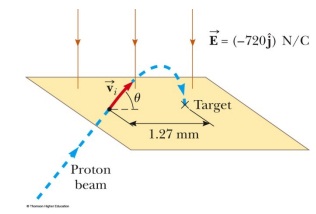Assignment:
Instructions: Identify all equations and show all intermediate steps in arriving at your answer to each question. If you do not show your work, the instructor reserves the right to deduct points even though you have the correct answer! If I cannot read your work, it's wrong. Use separate sheets of engineering paper for each problem, clearly marking each page with the problem number and your name.
1. In the figure, let q1 = 3.0*10-5 C, q2 = 5.0*10-6 C, q3 = 6.0*10-5 C, and d = 30 cm, what is the magnitude of the electrostatic force on q3 due to charges q1 and q2?

2. A relatively heavy pith ball in the figure has a mass of 1.5 g and has acquired 1 percent of the charge on a thin, ebonite rod by contact. If the charge on the rod is concentrated at one end and the distance of the pith ball from that end is 0.1 meter, what is the charge on the pith ball and the tension in the string? Assume the thread makes an angle of θ= 30o with respect the vertical?

3. Consider two charges, q1 = 5*10-8 C at location (-2 cm, 0) and q2 = -4*10-8 C at (1 cm, 4 cm). Determine the position where a third charge Q should be placed for it to feel zero net force.
4. Two 1.20-m plastic wires meet at a right angle. One segment carries +2.50 10-6 C of charge distribution uniformly along its length, and the other carries 2.50 10-6 C distributed uniformly along it, as shown in figure below.
a. Find the magnitude and direction of the electric field these wires produce at point P, which is 1.20 m from the end of each wire.
b. If an electron is released from rest at P, what are the magnitude and direction of the net force and its acceleration that these wires exert on it?

5. Two point charges q1 and q2 are held in place 4.50 cm apart. Another point charge Q = 1.75 10-6 C of mass 5.00 g is initially located 3.00 cm from q1 and q2 as shown in the figure below. When Q is released from rest you observe that the initial acceleration of Q is 324 m/s2 upward, parallel to the line connecting the two point charges q1 and q2. Determine the amount of charge for q1 and q2.

6. An alpha particle is a helium nucleus and therefore consists of two protons and two neutrons. Such particle has an initial velocity of +1.60x103m/s xˆ ar and enters a region where the electric field is E→=-500.N / Cxˆ.
a) How much time passes before the alpha particle comes to rest?
b) How far has the alpha particle traveled during this time?
7. (Bonus Question) Protons are projected into a region of space where there is a uniform electric field of (-720 jˆor yˆ) N/C directed downward parallel to they-axis (see figure below). The initial velocity of the protons as they pass the origin is H= 5.00x104m/s. The protons are to hit a target that lies at a horizontal distance of 1.27 mm from the point where the protons cross the plane and enter the electric field. Find the following:
a) The projection angles θ that will result in hitting the target.
b) The time of flight (that is, the time interval during which the proton is above the plane in the figure below) for each trajectory
